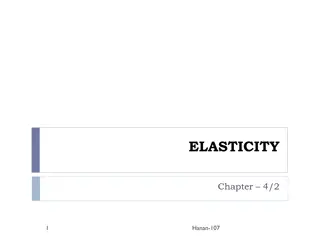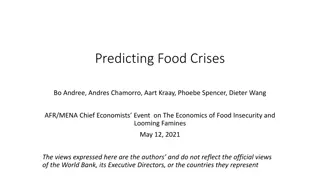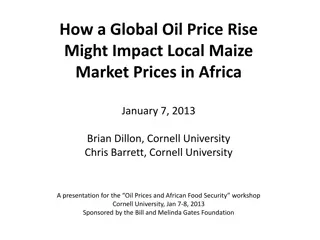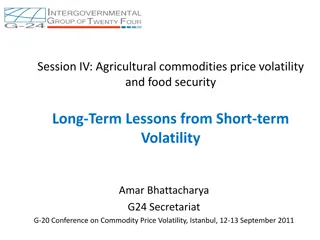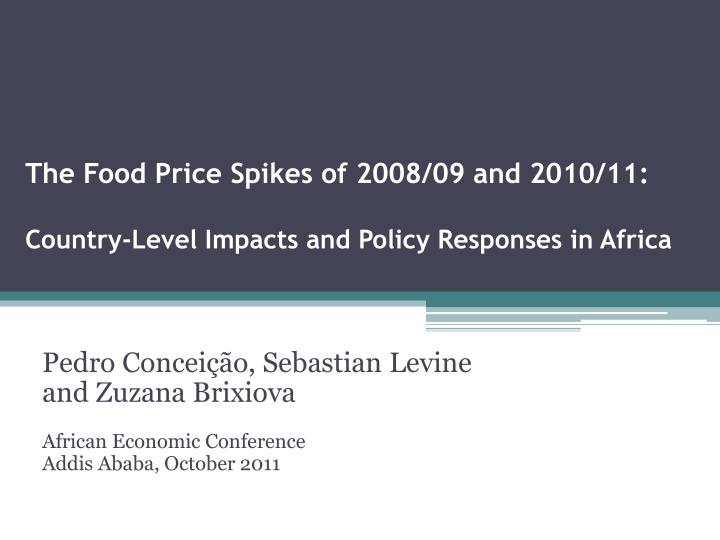
Country-Level Impacts and Policy Responses to Food Price Spikes in Africa
This study examines the impact of food price spikes in Africa during 2008/09 and 2010/11, analyzing vulnerabilities, policy responses, and consequences on consumer prices and household welfare. It delves into differences between the price spikes, conceptual frameworks, and the effectiveness of monetary policies and surveys of national policy responses.
Uploaded on | 1 Views
Download Presentation

Please find below an Image/Link to download the presentation.
The content on the website is provided AS IS for your information and personal use only. It may not be sold, licensed, or shared on other websites without obtaining consent from the author. If you encounter any issues during the download, it is possible that the publisher has removed the file from their server.
You are allowed to download the files provided on this website for personal or commercial use, subject to the condition that they are used lawfully. All files are the property of their respective owners.
The content on the website is provided AS IS for your information and personal use only. It may not be sold, licensed, or shared on other websites without obtaining consent from the author.
E N D
Presentation Transcript
The Food Price Spikes of 2008/09 and 2010/11: Country-Level Impacts and Policy Responses in Africa Pedro Concei o, Sebastian Levine and Zuzana Brixiova African Economic Conference Addis Ababa, October 2011
Overview Background Conceptual framework Impacts and vulnerabilities Policy responses Conclusions
Differences between the two price spikes 1. Type and number of commodities affected 2. Limited pass-through of global to local prices in 2010/11 relative to 2007/08 3. Varied policy responses Reduced fiscal space after the global financial crisis limited macro policy responses in 2010/11
Policy responses Survey of RMCs In 2011, UNDP RBA conducted a survey of national policy responses through its country offices; Total of 33 countries included in responses Policy responses adopted by SSA countries in 2007/08 and 2010/2011 are classified according to: overall type (macro, micro/social at the household, level and structural/sectoral) channels by which they operate (supply/demand), likely timing of their impact (short vs. long term).
Policy responses (% of SSA sub-groups) Market (macro) interventions, by SSA sub-groups (% of countries) 100 Cut of import tariffs Price controls Release from reserves Export restritions or ban VAT or sales tax cut None 80 60 40 20 0 2007/08 2010/11 2007/08 2010/11 2007/08 2010/11 Oil-exporters MICs, non-oil LICs, non-oil Structural and sectoral measures, by SSA sub-groups (% of countries) 90 Investment in rural infrastructure Budget allocation to agriculture Land lease arrangements 80 70 60 50 40 30 20 10 0 2007/08 2010/11 2007/08 2010/11 2007/08 2010/11 Oil-exporters MICs, non-oil LICs, non-oil
Conclusions Similarities between the two price spikes in 2007/08 and 2010/11. Key differences: Different commodities affected, limited pass-through, different policy responses. Between African countries also significant heterogeneity reflecting differences in exposure, vulnerability, policy space and coping strategies.
Conclusions (cont.) Invest in agriculture, raise productivity and mitigate impacts of climate change Facilitate supply responses, deepen markets (cross-border trade, RD, infrastructure) National and regional policy coordination (both on structural reserves and macro policies) Social protection to build resilience and raise productivity Reduce domestic market volatility (credit, storage, insurance, commodity exchanges)













